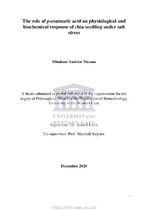| dc.description.abstract | The role of phenolic acids in mitigating salt stress tolerance have been well documented. However, there are contradicting reports on the effect of exogenously applied phenolic acids on the growth and development of various plants species. A general trend was observed where phenolic acids were shown to inhibit plant growth and development, with the exception of a few documented cases. One of these such cases is presented in this thesis. This study investigates the role of exogenously applied p-coumaric acid (p-CA) on physio-biochemical and molecular responses of chia seedlings under salt stress. This study is divided into three parts. Part one (Chapter 3) focuses on the impact of exogenous p-coumaric acid on the growth and development of chia seedlings. In this section, chia seedlings were supplemented with exogenous p-CA and the various biochemical and plant growth parameters were measured. The results showed that exogenous p-CA enhanced the growth of chia seedlings. An increase in chlorophyll, proline and superoxide oxide contents were also observed in the p-CA treatment relative to the control. We suggested that the increase in chia seedling growth could possibly be via the activation of reactive oxygen species-signalling pathway involving O2− under the control of proline accumulation (Chapter 3). Given the allopathy, nature of p-coumaric acid it is noteworthy that the response observed in this study may be species dependent, as contrasting responses have been reported in other plant species. Part two (Chapter 4) of this study investigates the influence of piperonylic acid (an inhibitor of endogenous p-coumaric acid) on the growth and development of chia seedlings.
In trying to illustrate whether p-CA does play a regulatory role in enhancing pseudocereal plant growth, we treated chia seedlings with the irreversible inhibitor of C4H enzyme, to inhibit the biosynthesis of endogenous p-CA. In this section, chia seedlings were treated with piperonylic acid and changes in plant growth, ROS-induced oxidative damage, p-CA content and antioxidant capacity was monitored. Inhibition of endogenous p-CA restricted chia seedling growth by enhancing ROS-induced oxidative damage as seen for increased levels of superoxide, hydrogen peroxide and the extent of lipid peroxidation. Although an increase in antioxidant activity was observed in response to piperonylic acid, this increase was not sufficient to scavenge the ROS molecules to prevent oxidative damage and ultimate cellular death manifested as reduced plant growth. The results presented in this section support our hypothesis that p-CA play an important regulatory role in enhancing chia seedling growth and development as shown in Chapter 3. Part three (Chapter 5) seeks to identify and functionally characterise p-coumaric acid induced putative protein biomarkers under salt stress conditions in chia seedlings.
Previous studies have shown that p-CA reversing the negative effect caused by NaCl-induced salt stress. While these studies were able to demonstrate the involvement of p-CA in promoting plant growth under salt stress conditions, they focussed primarily on the physiological aspect, which lacks in-depth biochemical and molecular analysis (ionomic and proteomic data) which could help in detecting the genes/proteins involved in salt stress tolerance mechanisms. A comparative ionomics and proteomic study was conducted, with the aim of elucidating the pivotal roles of essential macro elements and/or key protein markers involved in p-CA induced salt stress tolerance in chia seedlings. With the exception of Na, all the other macro elements were decreased in the salt treatment. Contrary to what was observed for the salt treatment most of the macro elements were increased in the p-CA treatment. However, the addition of exogenous p-CA to salt stressed seedlings showed an increase in essential macro elements such as Mg and Ca which have been shown to play a key role in plant growth and development. In the proteomic analysis we identified 907 proteins associated with shoots across all treatments. Interestingly, only eight proteins were conserved amongst all treatments. A total of 79 proteins were unique to the p-CA, 26 to the combination treatment (NaCl + p-CA) and only two proteins were unique to the salt stress treatment. The unique proteins identified in each of the treatments were functionally characterised to various subcellular compartments and biological processes. Most of the positively identified proteins were localised to the chloroplast and plays key roles in photosynthesis, transportation, stress responses and signal transduction pathways. Moreover, the protein biomarkers identified in this study (especially in the p-CA treatment) are putative candidates for genetic improvement of salt stress tolerance in plants. | en_US |

